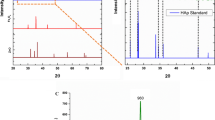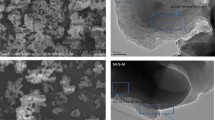Abstract
The production of large amounts of uranium-containing wastewater and its potential hazards has stimulated green and efficient material removal of uranium (VI). Inspired by the natural mineralization of bone, a facile and eco-friendly biomimetic synthesis of nano-hydroxyapatite (HAP) was carried out using chitosan (CS) as a template. It was found that the reaction temperature and the amount of precursors influence the particle size, crystallinity and specific surface area of the CS/HAP nanorods, and consequently their U(VI) adsorption efficiency. Moreover, the synthesized CS/HAP-40 with smaller particle size, lower crystallinity, and larger specific surface area show a more efficient U(VI) removal compared with CS/HAP-55 and CS/HAP-55-AT. It has a maximum adsorption capacity of 294.12 mg·g−1 of the CS/HAP-40. Interestingly, the U(VI) removal mechanism of CS/HAP-40 in acidic (pH = 3) and alkaline (pH = 8) aqueous solutions was found to be different. As one of the main results, the U(VI) adsorption mechanisms at pH 8 could be surface complexation and ion exchange. On the contrary, three different mechanisms could be observed at pH 3: dissolution–precipitation to form chernikovite, surface complexation, and ion exchange.






Similar content being viewed by others
References
Ahmed W, Mehmood S, Núñez-Delgado A, Qaswar M, Ali S, Ying H, Liu Z, Mahmood M, Chen DY (2021a) Fabrication, characterization and U(VI) sorption properties of a novel biochar derived from Tribulus terrestris via two different approaches. Sci Total Environ 780:146617
Ahmed W, Núñez-Delgado A, Mehmood S, Ali S, Qaswar M, Shakoor A, Chen DY (2021b) Highly efficient uranium (VI) capture from aqueous solution by means of a hydroxyapatite-biochar nanocomposite: adsorption behavior and mechanism. Environ Res 201:111518
Bai ZQ, Yuan LY, Zhu L, Liu ZR, Chu SQ, Zheng LR, Zhang J, Chai ZF, Shi WQ (2015) Introduction of amino groups into acid-resistant MOFs for enhanced U(VI) sorption. J Mater Chem A 3:525–534
Cai X, Tong H, Shen X, Chen W, Yan J, Hu J (2009) Preparation and characterization of homogeneous chitosan–polylactic acid/hydroxyapatite nanocomposite for bone tissue engineering and evaluation of its mechanical properties. Acta Biomater 5:2693–2703
El-Maghrabi HH, Younes AA, Salem AR, Rabie K, El-shereafy ES (2019) Magnetically modified hydroxyapatite nanoparticles for the removal of uranium (VI): preparation, characterization and adsorption optimization. J Hazard Mater 378:120703
Fasfous II, Dawoud JN (2012) Uranium (VI) sorption by multiwalled carbon nanotubes from aqueous solution. Appl Surf Sci 259:433–440
Guo Y, Gong Z, Li C, Gao B, Li P, Wang X, Zhang B, Li X (2020) Efficient removal of uranium (VI) by 3D hierarchical Mg/Fe-LDH supported nanoscale hydroxyapatite: a synthetic experimental and mechanism studies. Chem Eng J 392:123682
He J, Zhang K, Wu S, Cai X, Chen K, Li Y, Sun B, Jia Y, Meng F, Jin Z, Kong L, Liu J (2016) Performance of novel hydroxyapatite nanowires in treatment of fluoride contaminated water. J Hazard Mater 303:119–130
İsmaeili J, Irani M, Aliabadi M, Najafzadeh S (2013) Design and evaluation of chitosan/hydroxyapatite composite nanofiber membrane for the removal of heavy metal ions from aqueous solution. J Taiwan Inst Chem E 45:518–526
Kong L, Zhang H, Ji W, Shih K, Su M, Diao Z, Xu R, Hou L, Song G, Chen D (2018) Recovery of phosphorus rich krill shell biowaste for uranium immobilization: a study of sorption behavior, surface reaction, and phase transformation. Environ Pollut 243:630–636
Ladeira A, Gonçalves C (2007) Influence of anionic species on uranium separation from acid mine water using strong base resins. J Hazard Mater 148:499–504
Lammers LN, Rasmussen H, Adilman D, deLemos JL, Zeeb P, Larson DG, Quicksall AN (2017) Groundwater uranium stabilization by a metastable hydroxyapatite. Appl Geochem 84:105–113
Li D, Kaplan DI (2012) Sorption coefficients and molecular mechanisms of Pu, U, Np, Am and Tc to Fe (hydr)oxides: a review. J Hazard Mater 243:1–18
Li J, Chen Y, Yin Y, Yao F (2007) Modulation of nano-hydroxyapatite size via formation on chitosan-gelatin network film in situ. Biomaterials 28:781–790
Li L, Iqbal J, Zhu Y, Zhang P, Chen W, Bhatnagar A, Du Y (2018) Chitosan/Ag-hydroxyapatite nanocomposite beads as a potential adsorbent for the efficient removal of toxic aquatic pollutants. Int J Biol Macromol 120:1752–1759
Li L, Wu H, Chen J, Xu L, Sheng G, Fang P, Du K, Shen C, Guo X (2021) Anchoring nanoscale iron sulfide onto graphene oxide for the highly efficient immobilization of uranium (VI) from aqueous solutions. J Mol Liq 332:115910
Liao J, Liu P, Xie Y, Zhang Y (2021) Metal oxide aerogels: preparation and application for the uranium removal from aqueous solution. Sci Total Environ 768:144212
Liu S, Ma J, Zhang W, Luo F, Luo M, Li F, Wu L (2015) Three-dimensional graphene oxide/phytic acid composite for uranium(VI) sorption. J Radioanal Nucl Chem 306:507–514
Liu H, Xie S, Liao J, Yan T, Liu Y, Tang X (2018) Novel graphene oxide/bentonite composite for uranium(VI) adsorption from aqueous solution. J Radioanal Nucl Chem 317:1–12
Liu H, Zhou Y, Yang Y, Zou K, Wu R, Xia K, Xie S (2019) Synthesis of polyethylenimine/graphene oxide for the adsorption of U(VI) from aqueous solution. Appl Surf Sci 471:88–95
Ma Y, Zhang J, Guo S, Shi J, Du W, Wang Z, Ye L, Gu W (2016) Biomimetic mineralization of nano-sized, needle-like hydroxyapatite with ultrahigh capacity for lysozyme adsorption. Mater Sci Eng C 68:551–556
Peng Y, Zhang Y, Tan Q, Huang H (2021) Bioinspired construction of uranium ion trap with abundant phosphate functional groups. ACS Aappl Mater Interf 13:27049–27056
Philipp T, Shams Aldin Azzam S, Rossberg A, Huittinen N, Schmeide K, Stumpf T (2019) U(VI) sorption on Ca-bentonite at (hyper)alkaline conditions - spectroscopic investigations of retention mechanisms. Sci Total Environ 676:469–481
Pinto AJ, Gonçalves MA, Prazeres C, Astilleros JM, Batista MJ (2012) Mineral replacement reactions in naturally occurring hydrated uranyl phosphates from the Tarabau deposit: examples in the Cu–Ba uranyl phosphate system. Chem Geol 312–313:18–26
Sobierajska P, Wiglusz RJ (2019) Influence of the grain sizes on Stokes and anti-Stokes fluorescence in the Yb3+ and Tb3+ ions co-doped nanocrystalline fluorapatite. J Alloy Comp 785:808–818
Song J, Kong H, Jang J (2011) Adsorption of heavy metal ions from aqueous solution by polyrhodanine-encapsulated magnetic nanoparticles. J Colloid Interf Sci 359:505–511
Stötzel C, Müller F, Reinert F, Niederdraenk F, Barralet J, Gbureck U (2009) Ion adsorption behavior of hydroxyapatite with different crystallinities. Colloids Surf B Biointerfaces 74:91–95
Su M, Tsang D, Ren X, Shi Q, Tang J, Zhang H, Kong L, Hou LA, Song G, Chen D (2019) Removal of U(VI) from nuclear mining effluent by porous hydroxyapatite: evaluation on characteristics, mechanisms and performance. Environ Pollut 254:112891
Wang G, Liu J, Wang X, Xie Z, Deng N (2009) Adsorption of uranium (VI) from aqueous solution onto cross-linked chitosan. J Hazard Mater 168:1053–1058
Wang Y, Moo YX, Chen C, Gunawan P, Xu R (2010) Fast precipitation of uniform CaCO3 nanospheres and their transformation to hollow hydroxyapatite nanospheres. J Colloid Interf Sci 352:393–400
Wang M, Qiu J, Tao X, Wu C, Cui W, Liu Q, Lu S (2011) Effect of pH and ionic strength on U(IV) sorption to oxidized multiwalled carbon nanotubes. J Radioanal Nucl Chem 288:895–901
Wang D, Guan X, Huang F, Li S, Shen Y, Chen J, Long H (2016a) Removal of heavy metal ions by biogenic hydroxyapatite: morphology influence and mechanism study. Russ J Phys Chem A 90:1557–1562
Wang L, Yuan LY, Chen K, Zhang YJ, Deng Q, Du S, Huang Q, Zheng L, Zhang J, Chai Z, Barsoum M, Wang X, Shi WQ (2016b) Loading actinides in multilayered structures for nuclear waste treatment: the first case study of uranium capture with vanadium carbide MXene. ACS Appl Mater Interf 8:16396–16403
Wang Y, Xue J, Nie G, Guo X (2020) Uranium adsorption on two-dimensional irradiation resistant MXenes from first-principles calculations. Chem Phys Lett 750:137444
Wang Y, Hu X, Liu Y, Li Y, Lan T, Wang C, Liu Y, Yuan D, Cao X, He H, Zhou L, Liu Z, Chew JW (2021) Assembly of three-dimensional ultralight poly(amidoxime)/graphene oxide nanoribbons aerogel for efficient removal of uranium(VI) from water samples. Sci Total Environ 765:142686
Wen H, Pan Z, Giammar D, Li L (2018) Enhanced uranium immobilization by phosphate amendment under variable geochemical and flow conditions: insights from reactive transport modeling. Environ Sci Technol 52:5841–5850
Wu F, Pu N, Ye G, Sun T, Wang Z, Song Y, Wang W, Huo X, Lu Y, Chen J (2017) Performance and mechanism of uranium adsorption from seawater to poly(dopamine)-inspired sorbents. Environ Sci Technol 51:4606–4614
Wu Y, Chen D, Kong L, Tsang DCW, Su M (2019) Rapid and effective removal of uranium (VI) from aqueous solution by facile synthesized hierarchical hollow hydroxyapatite microspheres. J Hazard Mater 371:397–405
Yang S, Huang Y, Huang G, Peng W, Guo C, Shi J (2020) Preparation of amidoxime-functionalized biopolymer/graphene oxide gels and their application in selective adsorption separation of U(VI) from aqueous solution. J Radioanal Nucl Chem 324:847–855
Zeng H, Lu L, Gong Z, Guo Y, Mo J, Zhang W, Li H (2019) Nanoscale composites of hydroxyapatite coated with zero valent iron: preparation, characterization and uranium removal. J Radioanal Nucl Chem 320:165–177
Zhang W, Liu H, Fan X, Zhuo Z, Guo Y (2020a) Removal of uranium from aqueous solution by a permeable reactive barrier loaded with hydroxyapatite-coated quartz sand: implication for groundwater remediation. Geochemistry 80:125545
Zhang ZH, Lan JH, Yuan LY, Sheng PP, He MY, Zheng LR, Chen Q, Chai ZF, Gibson JK, Shi WQ (2020b) Rational construction of porous metal–organic frameworks for uranium(VI) extraction: the strong periodic tendency with a metal node. ACS Appl Mater Interf 12:14087–14094
Zhao Y, Li J, Zhang S, Chen H, Shao D (2013) Efficient enrichment of uranium(vi) on amidoximated magnetite/graphene oxide composites. RSC Adv 3:18952–18959
Zhao D, Gao X, Chen S, Xie F, Feng S, Alsaedi A, Hayat T, Chen C (2018) Interaction between U(VI) with sulfhydryl groups functionalized graphene oxides investigated by batch and spectroscopic techniques. J Colloid Interf Sci 524:129–138
Zheng N, Yin L, Su M, Liu Z, Tsang DCW, Chen D (2020) Synthesis of shape and structure-dependent hydroxyapatite nanostructures as a superior adsorbent for removal of U(VI). Chem Eng J 384:123262
Zou X, Zhao Y, Zhang Z (2019) Preparation of hydroxyapatite nanostructures with different morphologies and adsorption behavior on seven heavy metals ions. J Contam Hydrol 226:103538
Acknowledgements
The authors would like to express their gratitude to EditSprings (https://www.editsprings.com/) for the expert linguistic services provided.
Funding
This work was supported by the Natural Science Foundation of Hunan Province (Grant No. 2021JJ30563), China Postdoctoral Science Foundation (2021M692984), and the Opening Project of Cooperative Innovation Center for Nuclear Fuel Cycle Technology and Equipment, University of South China.
Author information
Authors and Affiliations
Contributions
Hongjuan Liu: methodology, investigation, data curation, writing—original draft. Xi Wang: data curation, investigation. Yongjiang Li: data curation, investigation. Zefu Min: data curation, investigation. Hang You: data curation, investigation. Shuibo Xie: writing—review and editing. Yingjiu Liu: resources, investigation. Huaming Yang: resources, writing—review and editing, supervision.
Corresponding author
Ethics declarations
Ethics approval and consent to participate
Not applicable.
Consent to participate
All the authors listed have approved the manuscript.
Consent to publication
This manuscript is approved by all authors for publication in Environmental Science and Pollution Research.
Competing interests
The authors declare no competing interests.
Additional information
Responsible Editor: Tito Roberto Cadaval Jr
Publisher's note
Springer Nature remains neutral with regard to jurisdictional claims in published maps and institutional affiliations.
Supplementary Information
Below is the link to the electronic supplementary material.
Rights and permissions
Springer Nature or its licensor holds exclusive rights to this article under a publishing agreement with the author(s) or other rightsholder(s); author self-archiving of the accepted manuscript version of this article is solely governed by the terms of such publishing agreement and applicable law.
About this article
Cite this article
Liu, H., Wang, X., Li, Y. et al. Efficient uranium(VI) adsorbing bioinspired nano-sized hydroxyapatite composites: synthesis, tuning, and adsorption mechanism. Environ Sci Pollut Res 30, 18156–18167 (2023). https://doi.org/10.1007/s11356-022-23492-w
Received:
Accepted:
Published:
Issue Date:
DOI: https://doi.org/10.1007/s11356-022-23492-w




